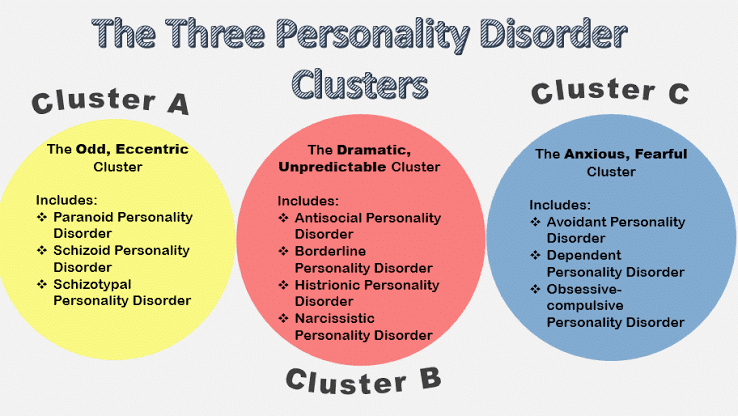Introduction
We have been studying human personality characteristics for thousands of years but the concept of personality disorders is a much-newer idea.
Personality disorders are psychological disorders that are inflexible, disruptive, and enduring behavior patterns that act as a barrier in social and other settings whether the sufferer recognizes that or not. Personality disorders are chronic and create noticeable problems in life.
According to the Diagnostic and Statistics Manual of Mental Disorders (DSM-5), a personality disorder is an enduring pattern of inner experience and behavior that deviates markedly from the expectations of the individual’s culture.
9% of Americans over the age of 18 and 6% of the entire population have some sort of personality disorder where borderline personality disorder and antisocial personality disorder are two of the frequently diagnosed personality disorders. This condition may cause a person to struggle to find work, maintain important relationships, and just live a normal happy life.
From a range of self-assessment tests conducted, it was qualified that the symptoms of any personality disorder can range from harmless displays of narcissism to a true and troubling lack of empathy for other people.
Are Relationships Challenging Due to Personality Disorder?
Types of Personality Disorders
DSM-5 divides personality disorders into 3 clusters as mentioned below:

Cluster A
The first cluster is regarded as Cluster A is recognized by odd and eccentric behaviors in people and we have three personality disorders under this cluster:
1. Paranoid Personality Disorder
People with this personality disorder aren’t just paranoid in general but their experiences, feelings, and emotions are not based on reality. It causes them to be highly suspicious of everyone around them and they would genuinely believe that everyone around them has all arms towards them. They would eventually be reluctant to share information and be active in social settings.
A classic example of this disorder is the movie “The Aviator” where Leonardo DiCaprio’s character displays symptoms of this disorder as he has obsessive-compulsive personality disorder throughout the film, and it worsens when he starts to become overly paranoid and displays an array of eccentric behaviors.
2. Schizoid Personality Disorder
People with this disorder do not have hallucinations or hear strange voices and in fact, most people with schizoid personality disorder can seem to live a normal life with a normal job. However, they have a problem having long-term and meaningful relationships with others as they seem to be detached from them.
Christian Grey from 50 Shades of Grey happens to display symptoms of this disorder as people with this disorder prefer to be alone and are not moved by emotional connections from others. As they are close to reality, they hesitate to get help for their disorder as everything seems normal to them.
3. Schizotypal Personality Disorder
The phrase may look similar to schizophrenia and schizoid personality disorder by these are entirely different conversations. Imagine someone living in their strange beliefs and fantasizing literally about everything, that is what a person with schizotypal personality disorder looks like.
Gene Wilder from Willy Wonka and the Chocolate Factory portrays schizotypal personality disorder. He created an entire world made of candy and his speech was very strange. Willy Wonka also secluded himself for years in this world of his own creation and was paranoid about people stealing his recipes in his fortune.
Cluster B
Moving forward to Cluster B also known as the dramatic cluster, people with these disorders have been observed to be emotional and display erratic behaviors. Here are 4 personality disorders listed under this cluster:
1. Antisocial Personality Disorder
As the name gives us a strong reference, people with antisocial personality disorder isolate themselves. Antisocial personality disorder describes a condition where people blatantly disregard the rights of others through impulsive, manipulative, or downright criminal behavior. Most serious cases of antisocial personality disorder usually include psychopaths. They are aggressive, lack remorse, and use deceit to get things done their way.
Christian Bale’s character in American Psycho is a classic but very extreme case of antisocial personality disorder and psychologists have said that he displays symptoms of borderline personality disorder and schizotypal personality disorder too.
2. Narcissist Personality Disorder
If you search for “narcissist personality disorder meaning”, this is probably what you would get at the top of the search result. People with NPD tend to have no connection with other’s feelings and are mostly self-centered. This can be paired with arrogance not based on reality as they feel they are someone special who needs to be treated the right way every time by everyone. This also fuels them to do and achieve anything they want even if it’s not the right thing to do by law.
Ted Bundy is a classic case of narcissistic personality disorder. Also, Donald Trump is considered to be one of the most famous people depicted as a narcissistic personality by tens and thousands of mental health professionals.
3. Histrionic Personality Disorder
These are highly attention-seekers and consider themselves the life of the party. Most of them happen to be charming and outgoing, and hence are in constant need to be accepted, validated, and appreciated at all times. HPD is commonly characterized by the seductive and overly emotional behavior of the person. They tend to become upset and dramatic when they don’t get the attention they need.
Michael Scott from The Office is a classic case of histrionic personality disorder where he tends to seek everyone’s attention at all times.
4. Borderline Personality Disorder
Borderline Personality Disorder, BPD is considered similar to paranoid personality disorder but is often symptomized with mood swings and other erratic behavior. People with BPD happen to engage in risky activities and be passionately aggressive toward others.
Clementine from Eternal Sunshine of the Spotless Mind and Tiffany from Silver Linings Playbook are some movie characters displaying borderline personality disorder. Girl Interrupted is also about an author’s experience in a psychiatric hospital after being diagnosed with borderline personality disorder.
It is often confused with bipolar disorder. Bipolar Disorder is a mood disorder that involves intense periods of mania or depression people with a borderline personality disorder may also experience mood swings but their disorder mainly stems from and negatively affects their relationships.
Cluster C
The last cluster in the personality orders list is Cluster C where people going through these disorders tend to feel anxiety and fearful behaviors constantly. Here is the list of disorders under this cluster:
1. Avoidant Personality Disorder
People with this personality disorder are highly concerned about their reputation and what other people think of them but unlike people with histrionic personality disorder, they hardly take risks to go the extra mile and consider themselves to be trapped. They, instead avoid situations due to the fear of being rejected and being mistreated by everyone. Sometimes, this even leads to prolonged negative feelings and can cause them to be completely cut off from society.
Elsa from Frozen Display portrays symptoms of this disorder. Traumatic events caused by her magical powers led her to be secluded for years out of fear.
2. Dependent Personality Disorder
As a child, it’s normal to experience something called separation anxiety and fear of being alone. As we grow up, we generally become less dependent and grow out of the fear of being alone, but people who can’t do it tend to have dependent personality disorder. They might have a difficult time functioning independently and all their decisions be they as basic as what you should eat for dinner to what you should wear for work, everything becomes an outside dependence.
People with DPD find it hard to complete their tasks alone as they always want someone’s validation to take them to the next level.
3. Obsessive-Compulsive Personality Disorder
People with obsessive-compulsive personality disorder get stuck in a perfection loop and desire to be the perfect one in the room. They make their rules hard to follow and live abiding by them every time and everywhere. They follow to-do lists and keep in mind particular details that can come in the way of developing meaningful and long-term relationships. On the other hand, people with OCD face excessive thoughts and obsessions which repeatedly shape how they want things to be. OCPD can be confused with obsessive-compulsive disorder (OCD) as they are similar but are not the same.
Unlike OCD, people with OCPD are not under the control of impulses like keeping everything clean and organized on their table or washing their hands a specific number of times. They plan stuff perfectly and then want to follow their plan with perfection. They can also lose sight of what they are doing currently due to being preoccupied with everything being on point. Hermione Granger from Harry Potter happens to display symptoms of OCPD.
In addition to the 10 personality disorders discussed above, there is another personality disorder that was removed from cluster 3 and placed in Appendix B. This is called passive-aggressive personality disorder, or negativistic personality disorder. This disorder causes people to express their negative feelings subtly rather than directly. It is a chronic and inflexible condition. Some of the strong symptoms of this type of disorder are intentionally missing deadlines, misplacing important stuff, arguing even when it’s not needed, feeling hopeless, etc.
Common Symptoms of Personality Disorder
While all the personality disorders mentioned above have different symptoms in particular, here are some common symptoms that can help you understand if you even have a personality disorder in general:
- Excessive distrust and suspicion of others, and assuming that everyone around you has evil intentions
- Severe emotional suppression, a strong distancing from social interactions, and a predilection for isolation
- Atypical conduct, strange convictions or mystical thinking, anxiety in social situations, and unusual thought processes
- Impulsivity, indifference to other people’s rights, and lack of empathy, involvement in criminal activity without regret
- Unbearable mood swings, impulsivity, self-harm, unstable self-image, and abandonment fear
- Insane emotional expression, a need for attention all the time, and discomfort in situations where one is not the focus
- An excessive sense of importance, a deficiency in empathy, and an unceasing demand for praise.
- An intense sensitivity to rejection, a social interaction avoidance strategy, and a fear of mockery or criticism.
- An inability to take initiative, an excessive reliance on others to make decisions, and a fear of being by oneself.
- The need for control, perfectionism, and an obsession with rules and order.
Diagnosis and Assessment of Personality Disorder:
Diagnosis typically involves a comprehensive assessment of an individual and based on the symptoms, the following are the common types of diagnosis that are being carried:
- Individual’s thoughts, behaviors, and history, with a focus on their pervasive mistrust and suspicion of others
- A history of conduct disorder, a pattern of manipulative behavior, and a lack of empathy or remorse.
- The instability of mood and relationships, impulsive behaviors, and self-harm tendencies.
Typically, a qualified mental health professional, like a psychologist or psychiatrist, is responsible for making a diagnosis. The assessment process includes a thorough review of the individual’s medical and psychological history, as well as interviews and standardized assessments.
The assessment considers the persistence of maladaptive patterns of thinking, feeling, and behaving across a range of situations and over time.
Causes and Risk Factors:
Genetic Factors
Inheritance: Genetic predisposition can be a significant factor in the development of personality disorders. Individuals with a family history of personality disorders, or even other mental health conditions, may be at a higher risk.

Gene-Environment Interaction: Genetic factors can interact with environmental influences, making some individuals more susceptible to personality disorders. Certain gene variants may increase vulnerability.

Childhood experiences
Trauma and Abuse: Childhood trauma, such as physical, emotional, or sexual abuse, can significantly increase the risk of developing a personality disorder. These early negative experiences can shape a person’s behavior and emotional responses.
Neglect: Neglect, including emotional neglect, can also have a profound impact on a child’s development and risk of developing personality disorders.
Inconsistent Parenting: Inconsistent or unpredictable parenting, where boundaries and expectations are unclear, can contribute to the development of personality disorders. Children may struggle with forming a stable sense of self.
Environmental influences
Family Environment: Growing up in a dysfunctional or unstable family environment can contribute to the development of personality disorders. Chaotic family dynamics, conflict, or inconsistent parenting styles can be risk factors.
Peer Relationships: Negative experiences with peers, such as bullying, rejection, or isolation, can influence the development of personality disorders, particularly in adolescence.
Cultural and Societal Influences: Cultural and societal factors can shape how personality disorders manifest. Cultural norms, expectations, and stigmatization of certain behaviors may influence the development of personality disorders.
Impact on Daily Life
What impact these personality disorders have on people depends upon their mindset and acceptance. Broadly classified, there are two types- ego-dystonic and ego-syntonic.
People who are ego-dystonic know that they have a problem and tend to be distressed by their symptoms. People with bipolar disorder and OCD are some examples in this category. On the other hand, ego-syntonic people don’t necessarily think they have a problem and sometimes, they even believe that the problem is with everyone else. Here are some of the areas where personality disorders have a major impact:
1. Personal Relationships:
Difficulty in Forming and Maintaining Relationships: Individuals with personality disorders often struggle with forming and maintaining close, healthy relationships. Their behaviors and emotional responses can create barriers to establishing deep connections with others.
Conflict and Instability: Many personality disorders, particularly borderline personality disorder and narcissist personality disorders, can lead to intense conflicts and instability in relationships. These individuals may have trouble regulating their emotions and may engage in impulsive or manipulative behaviors.
Fear of Abandonment: Several personality disorders, such as borderline personality disorder, are associated with a deep-seated fear of abandonment, which can lead to clingy or dramatic behavior, as well as emotional turmoil in relationships.
Isolation: Some individuals with personality disorders, such as schizoid personality disorder or avoidant personality disorder, may withdraw from social interactions, leading to social isolation and loneliness.
2. Work and Social Interactions:
Impaired Social Functioning: Personality disorders can lead to difficulties in social interactions and workplace dynamics. For example, individuals with avoidant personality disorder may struggle to participate in group activities or public speaking.
Conflict at Work: In the workplace, individuals with personality disorders may experience conflicts with colleagues or superiors due to their interpersonal challenges or impulsivity. This can lead to job instability and difficulties in career advancement.
Challenges in Team Settings: Group projects or teamwork can be particularly challenging for individuals with personality disorders, as they may struggle with collaboration, communication, and compromise.
3. Quality of Life:
Emotional Distress: Personality disorders are often accompanied by intense emotional distress. Individuals may experience frequent mood swings, anxiety, depression, and self-destructive behaviors, all of which can significantly reduce their overall quality of life.
Functional Impairment: The impact of a personality disorder on an individual’s daily life can lead to functional impairment in various areas, including self-care, employment, and overall life satisfaction.
Lower Life Satisfaction: Due to the challenges they face in personal relationships, work, and social interactions, individuals with personality disorders may experience lower life satisfaction and reduced overall well-being.
Treatment and Management of personality disorders
1. Psychotherapy:
– Individual Therapy: Psychotherapy, such as cognitive-behavioral therapy (CBT), dialectical behavior therapy (DBT), and schema-focused therapy, is often the primary treatment for personality disorders. These therapies help individuals explore and modify maladaptive thought patterns and behaviors.
– Group Therapy: Group therapy can be beneficial, as it provides a supportive environment where individuals with similar challenges can share experiences and learn from one another.
– Therapeutic Techniques: Therapists may use techniques like emotion regulation, interpersonal effectiveness, and distress tolerance to address specific issues associated with different personality disorders.
2. Medication:
– Medication is not a first-line treatment for personality disorders but may be used to manage certain symptoms or co-occurring conditions like depression or anxiety.
– Antidepressants, mood stabilizers, and antipsychotic medications are prescribed based on specific symptoms and the presence of comorbid disorders.
– Medication is often used in conjunction with psychotherapy.
3. Support from Loved Ones:
– Having a supportive and understanding network of family and friends is crucial for individuals with personality disorders.
– Emotional support can help reduce feelings of isolation and despair. Loved ones can learn about the specific personality disorder, attend therapy sessions together, and provide encouragement for treatment adherence.
– Healthy relationships can help individuals with personality disorders build self-esteem and improve their interpersonal skills.
4. The Importance of Reducing Stigma:
– Reducing the stigma surrounding personality disorders is essential to encourage affected individuals to seek help without fear of judgment.
– Education and awareness campaigns can help the public understand that personality disorders are real and serious mental health conditions, not simply a result of character flaws.
– Efforts to reduce stigma can lead to earlier diagnosis and intervention, improving overall outcomes.
5. Awareness and Advocacy :
– Advocacy organizations, mental health professionals, and affected individuals can work together to raise awareness about personality disorders.
– Advocacy efforts can include advocating for better mental health services, funding, and research related to personality disorders.
– Increased awareness can lead to improved access to care, early intervention, and more understanding of communities.
Your Path to Recovery Begins Here
Frequently Asked Questions (FAQ)
Que: What is Borderline Personality Disorder?
Ans: A mental health condition called borderline personality disorder affects how you think and feel about other people as well as yourself, making it difficult to go about your daily life normally. It includes a pattern of unstable relationships, difficulties controlling emotions and behavior, and problems with one’s own self-image.
If you have borderline personality disorder, you might find it difficult to accept being by yourself and have a strong fear of instability or abandonment. Even though you want to build enduring and loving relationships, inappropriate anger, impulsivity, and mood swings can drive people away.
Que: What is the difference between borderline personality disorder and bipolar disorder?
Ans: Bipolar disorder and borderline personality disorder are both characterized by impulsivity, mood swings, and unstable emotional experiences. However, issues with relationships and self-image are also present in people with borderline personality disorder. In particular, identity disorders like a shaky sense of self and persistent feelings of emptiness are present in people with borderline personality disorder.
Additionally, they alternate between viewing people as bad or unworthy and seeing them as good or worthy in their relationships. They have severe anxieties about being abandoned by people they depend on.
While the symptoms of bipolar disorder appear in episodes, the signs of borderline personality disorder are usually visible for at least a few years, though they seem to wax and wane over time.
Que: Is schizotypal personality disorder similar to schizophrenia?
Ans: Extreme discomfort in close personal relationships and a pattern of social and interpersonal problems are characteristics of schizotypal personality disorder. In addition to having strange behaviors, people with schizotypal personality disorder also have distorted thinking and perception.
Psychotic symptoms, including delusions, hallucinations, and disordered speech, are associated with schizophrenia. “Negative symptoms” of schizophrenia also include restricted emotional expression. Psychosis, or the inability to distinguish between reality and the creations of one’s imagination, is rare in people with schizotypal personality disorder.
Schizotypal personality disorder is frequently regarded as being on the “schizophrenia spectrum,” despite the fact that there are genetic and neurobiological similarities between it and schizophrenia.
Conclusion
Dealing with personality disorders can be challenging especially when you can see one or the other traits every time yourself. Expert guidance can help you save time and effort and streamline your process of recovery or help you get out of a delusion, either way. Relevance Recovery runs a personality disorder treatment program where you can opt-in for any type of therapy program but a borderline personality outpatient program can be the most effective as it helps you stay active in your daily routine while improving yourself through the therapy sessions by our experts.









